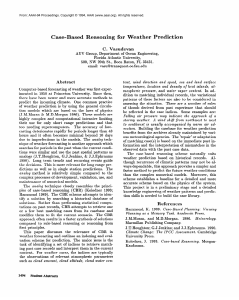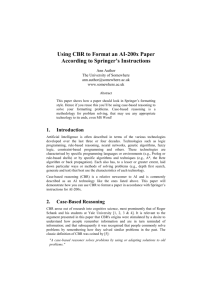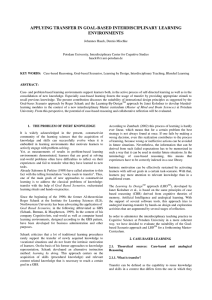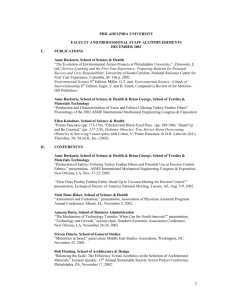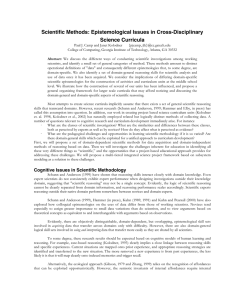Instructional Design: Case-Based Reasoning
advertisement
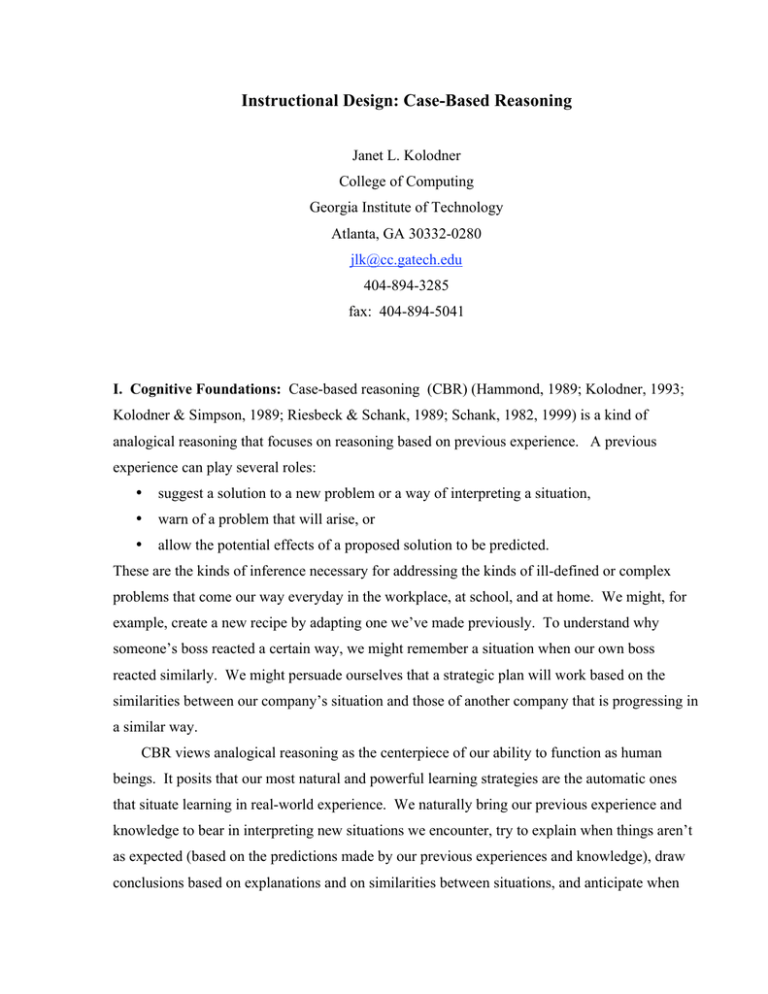
Instructional Design: Case-Based Reasoning Janet L. Kolodner College of Computing Georgia Institute of Technology Atlanta, GA 30332-0280 jlk@cc.gatech.edu 404-894-3285 fax: 404-894-5041 I. Cognitive Foundations: Case-based reasoning (CBR) (Hammond, 1989; Kolodner, 1993; Kolodner & Simpson, 1989; Riesbeck & Schank, 1989; Schank, 1982, 1999) is a kind of analogical reasoning that focuses on reasoning based on previous experience. A previous experience can play several roles: • suggest a solution to a new problem or a way of interpreting a situation, • warn of a problem that will arise, or • allow the potential effects of a proposed solution to be predicted. These are the kinds of inference necessary for addressing the kinds of ill-defined or complex problems that come our way everyday in the workplace, at school, and at home. We might, for example, create a new recipe by adapting one we’ve made previously. To understand why someone’s boss reacted a certain way, we might remember a situation when our own boss reacted similarly. We might persuade ourselves that a strategic plan will work based on the similarities between our company’s situation and those of another company that is progressing in a similar way. CBR views analogical reasoning as the centerpiece of our ability to function as human beings. It posits that our most natural and powerful learning strategies are the automatic ones that situate learning in real-world experience. We naturally bring our previous experience and knowledge to bear in interpreting new situations we encounter, try to explain when things aren’t as expected (based on the predictions made by our previous experiences and knowledge), draw conclusions based on explanations and on similarities between situations, and anticipate when this new thing we’ve just learned might be applicable. To do these things automatically, we must have some internal processes and representations that allow a new experience to call up similar ones from memory. Key to such reasoning is a memory that can access the right experiences (cases) at the times they are needed (the indexing problem). CBR identifies two sets of procedures that allow such recognition to happen. (1) At insertion (encoding) time, while engaging in an experience, a reasoner interprets the situation and identifies at least some of the lessons it can teach and when those lessons might most productively be applied. The case is labeled according to its applicability conditions, i.e., the circumstances in which it ought to be retrieved. The most discriminating labels on a case will be derived by a reasoner that has taken the time and effort, and that has the background knowledge, to carefully analyze a case's potential applicability. (2) At retrieval time, while engaging in a new situation, a reasoner uses his/her current goals and understanding of the new situation as a probe into memory, looking for cases that are usefully similar to the new one. The extent to which a reasoner is willing or able to interpret the new situation determines the quality of the probe into memory. An uninterpreted situation is likely to yield poorer access to the contents of memory than is one that is more embellished. The more creative a reasoner is at interpreting a situation, the more likely he or she is to find relevant knowledge and experience to use in reasoning about it. Learning, in the CBR paradigm, means extending one's knowledge by interpreting new experiences and incorporating them into memory, by re-interpreting and re-indexing old experiences to make them more usable and accessible, and by abstracting out generalizations over a set of experiences. Interpreting an experience means creating an explanation that connects one’s goals and actions with resulting outcomes. Such learning depends heavily on the reasoner’s ability to create such explanations, suggesting that the ability and need to explain are key to promoting learning. CBR thus gives failure a central role in promoting learning because failure promotes a need to explain. When the reasoner's expectations fail, it is alerted that its knowledge or reasoning is deficient. When such failures happen in the context of attempting to achieve a personallymeaningful goal, the reasoner wants to explain so that it can be more successful. Crucial to recognizing and interpreting failure is useful feedback from the world. A reasoner that is connected to the world will be able to evaluate its solutions with respect to what results from them, allowing indexing that discriminates usability of old cases and allowing good judgments later about reuse. Because one’s first explanations might not be complete or accurate, iterative refinement is central to CBR. We revise and refine our explanations (and thus, our knowledge) over time. We explain and index any experience the best we can at the time, and later on, when a similar situation comes up, we remember and try to apply what we learned from the past experience. The ability to accurately explain develops over time through noticing similarities and differences across diverse situations (e.g., Kolodner, 1993; Holyoak, 1984, Redmond, 1992), suggesting that a variety of experiences with a concept or skill, personal ones and vicarious ones, are necessary to learn it to its full complexity. II. Implications for Promoting Learning: CBR suggests five important facilitators for learning effectively from experience (Kolodner et al., 1996; Kolodner, 1997; Kolodner & Guzdial, 1999): (a) having the kinds of experiences that afford learning what needs to be learned, (b) interpreting those experiences so as to recognize what can be learned from them, to draw connections between their parts so as to transform them into useful cases, and to extract lessons that might be applied elsewhere, (c) anticipating the usefulness of those extracted lessons so as to be able to develop indexes for these cases that will allow their applicability to be recognized in the future, (d) applying what one is learning and experiencing failure of one’s conceptions to work as expected, explaining those failures, and trying again (iteration), and (e) learning to use cases effectively to reason. CBR suggests that the easiest kinds of experiences to learn from are those that afford concrete, authentic, and timely feedback, so that learners have the opportunity to confront their conceptions and identify what they still need to learn. It also suggests that learners be given the opportunity to iteratively move toward better and better development of the skills and concepts they are learning so as to experience them in a range of situations and under a variety of conditions, and that, with each iteration, they have a chance to explain things that didn’t go exactly as expected and identify what else they need to learn. According to CBR, the iterative cycle of applying what we know, interpreting feedback, explaining results, and revising memory explains how we develop expertise and how an expert uses his/her own experiences and those of others to reason and learn (Kolodner, 1993, 1997; Schank, 1982, 1999). III. Designing Instruction: CBR makes two kinds of suggestions about designing instruction. First, it suggests ways of orchestrating and sequencing classroom activities, including the roles teachers and peers can play in that orchestration and ways of integrating hands-on activities, software tools, and reflection. Second, it suggests several kinds of software tools for scaffolding and enhancing reasoning and for promoting productive kinds of reflection. III.A. Design of Learning Environments: CBR suggests a style of education in which students learn by engaging in problem solving and other activities that motivate the need to learn and that give students a chance to apply what is being learned in ways that afford real feedback (Kolodner et al., 1996; Kolodner, 1997; Schank & Cleary, 1994). In such an environment, students might engage in solving a series of real-world problems (e.g., managing erosion, planning for a tunnel, designing locker organizers) requiring identification of issues that need resolution and knowledge that needs to be learned to address those issues, exploration or investigation or experimentation to learn the needed knowledge, application of that knowledge to solve the problem, and generation and assessment of a solution. Thinking about the problem they are trying to solve should help learners identify what they need to learn, they should have opportunities to learn those things, and they should get to apply what they are learning over and over again, with help along the way aimed at allowing them to successfully solve the problem and successfully learn the targeted knowledge and skills. Two approaches to the design of full learning environments have come from CBR. Schank’s group at Northwestern University’s Institute for the Learning Sciences proposed the notion of a Goal-Based Scenario (Ferguson, et al., 1992; Schank et al., 1994; Schank & Cleary, 1994) as a fully-automated learning environment. Kolodner’s group at Georgia Institute of Technology proposes the notion of Learning by Design™ (Hmelo et al., 2000; Kolodner et al., 1998, 2002, 2003), a way of orchestrating a classroom for combined learning of content and important skills. III.A.1. Goal-Based Scenarios (GBS): A goal-based scenario is a learning environment that places students in a situation where they have to achieve some interesting goal that requires them to learn targeted knowledge and skills. In Advise the President, for example, students play the role of advisors to the President in dealing with a hostage situation in a foreign land (Bareiss & Beckwith, 1993; Schank & Cleary, 1994), in the process learning about several hostage-taking events that have happened in history and also learning some foreign policy. In Sickle-Cell Counselor (Bell et al., 1994), students advise couples about their risk of having children with sickle-cell anemia, in the process learning about genetics in the context of sickle-cell disease. Using Broadcast News (Schank et al., 1994; Kass & Garulnick, 1991), students put together a news story, in the process learning both history and writing skills. Students learn about history or genetics or writing because they need to learn those things to successfully achieve the challenge set for them. The trick is to design challenges that both engage the students and focus them on whatever is the content and skills we want them to be learning. The student engaged in a goal-based scenario is provided with a case library of videos of experts telling their stories, strategies, and perspectives that might help them with their task. When they reach an impasse in achieving their goal, they ask a question of the case library, and an appropriate video is retrieved and shown. Sometimes a story will suggest a topic they should learn more about or a skill they need to learn; other times it will tell how that expert dealt with some difficult issue the student is addressing. Based on suggestions made by the case library, students move forward with their task -- choosing a policy to recommend to the President, choosing a blood test, making a recommendation to a couples about whether or not they should have children, or deciding how to refer to a leader. The software takes on as an additional role to clearly inform students when they have failed at their task. The case library can be consulted again, this time to help with explaining and recovering from a failure. III.A.2. Learning by Design™: LBD (Hmelo, et al., 2000; Kolodner, 1997, Kolodner et al., 1998, 2002, 2003) is a project-based inquiry approach to middle school science that uses design challenges as compelling contexts for learning science concepts and skills. Design challenges provide opportunities for engaging in and learning complex cognitive, social, practical, and communication skills. For example, students design miniature vehicles and their propulsion systems to learn about forces, motion, and Newton’s laws and ways of managing the erosion near a basketball court to learn about erosion and accretion, erosion management, and the relationship between people and the environment. Learning by Design’s curriculum units are centered on the design and construction of working devices or models that illustrate physical phenomena. LBD’s focus on design challenges comes from CBR’s suggestion that learning requires impasses and expectation failures. Designing, building, and testing working devices provides the kinds of failure experiences and feedback that promote good learning as well as opportunities for trying again to achieve the challenge based on what’s been newly learned. CBR tells us that learning from experience requires reflecting on one’s experiences in ways that will allow learners to derive well-articulated cases from their experiences and insert them well into their own memories. Learning by Design has integrated into it classroom “rituals” (Kolodner et al., 2002, 2003) that promote such reflection. “Poster sessions” provide a venue for reporting on and discussing investigative results and procedures. “Pin-up sessions” give small groups the opportunity to share their plans with the whole class and hear other students’ ideas. “Gallery walks” provide a venue for presenting one’s designs in progress to the rest of the class and explaining why one’s device behaves the way it does. Each provides opportunities for students to publicly present the way they engaged in important science skills, to see how others have engaged in those skills, and to discuss the ins and outs of the skills being practiced. Preparing for presentations requires doing the kinds of reflection on their activities that CBR suggests will lead to lasting learning. Successfully engaging in design and investigative activities and in reflecting on those activities in ways that lead to productive learning requires help, and in LBD, that help is distributed between the teacher, peers, cases, software, and paper-and-pencil tools. Cases read as part of investigation or during design planning help students identify what they need to learn more about and give them ideas for their designs. Paper-and-pencil design diary pages (Puntambekar et al., 1998) help them keep track of decisions they make and data they collect while designing and testing so that they will be able to remember and reconstruct their experiences. SMILE’s (Nagel & Kolodner, 1999) Design Discussions (Kolodner & Nagel, 1999) help students plan investigative activities, summarize investigative experiences, justify design decisions, and explain design experiences, and its Lessons Learned helps them reflect back on a full design experience (several weeks long) and articulate what they’ve learned. The tools act as resources, help students create cases for others to use; help students keep track of what they’ve been doing; and help students reflect on their experiences and turn them into cases in their own memories. LBD’s classroom rituals get students and teachers involved in sharing and discussing experiences, providing advice, and abstracting across the experiences of different groups in a class. III.B. Design of Instructional Tools: CBR suggests three types of software tools for promoting learning: • Case libraries as a resource. • Supports for reflection. • Realistic simulation and modeling environments. III.B.1. Case Libraries as a Resource: The most common place where CBR has influenced learning tools is in the creation of case libraries. A case library offers the opportunity for students to learn from others’ experiences. Case libraries as a resource can offer a variety of different kinds of information of value to learners (Kolodner & Guzdial, 1999): • Advice in the form of stories • Vicarious experience using a concept or skill • The lay of the domain and guidance on what to focus on • Strategies and procedures • How to use cases ARCHIE-2 (Domeshek & Kolodner, 1993; Zimring et al., 1995), for example, provided cases for architecture students to use while designing. Its cases describe public buildings, focusing on libraries and courthouses. As students worked on designing buildings, they would consult Archie periodically for advice. STABLE (Guzdial & Kehoe, 1998) is designed to help students learn the skills involved in doing object-oriented design and programming. It uses a Web-based (hypermedia) collection of cases made from previous students’ work. Many GoalBased Scenarios include case libraries at their cores. The context in which case libraries are used is critical to their effectiveness. For cases to be a useful resource to students, the students must be engaged in an activity where their impasses might be answered by cases in the case library. If students are facing challenges that arise naturally in problem-solving (e.g., “How do I model a situation like this?” or “What’s a good starting point for this kind of problem?”), then a case library of relevant situations and problems can help them address those impasses. Building case libraries can be as valuable educationally as using case libraries, sometimes even more valuable. One of the findings in using Archie-2 was that the graduate students who were building the case library seemed to be learning as much or more than the students who were using the case library in their design work. The activity of building a case library is frequently motivating for students since it is creating a public artifact whose purpose is to help future students. Cognitively, the need to explain to others in a way that will allow them to understand requires reflecting on a situation, sorting out its complexities, making connections between its parts, and organizing what one has to say into coherent and memorable chunks (Collins et al., 1989). III.B.2. Support for reflection: CBR tells us that the most productive reflection for deep and lasting learning includes connecting one’s goals, plans, actions, and their outcomes to tell the fully-interpreted story of an experience, and then extracting out lessons learned and predictions about the circumstances when those lessons might be applicable in the future. Several software tools have been designed to help learners engage in such reflection, each asking learners to be authors of cases describing their experiences. Turns’ REFLECTIVE LEARNER (Turns et al., 1997) helps undergraduate engineering students write “learning essays” about their design experiences. Its prompting asks students to (a) identify and describe a problem that they had encountered when undertaking the current phase of their design project; (b) describe their solution to the problem; (c) say what they had learned from the experience; and (d) anticipate the kinds of situations where a similar solution might be useful. Shabo’s JAVACAP (Shabo et al., 1997) and its successors, Kolodner’s and Nagel’s STORYBOARD AUTHOR (Nagel & Kolodner, 1999) and Kolodner’s and Voida’s Lessons Learned (Kolodner & Voida, submitted), provide structuring and prompts to help middle-school students summarize their project-based science experiences, extract from them what they have learned, and write them up as stories for publication in a permanently-accessible case library for use by other students. The networked computer creates motivation for the students' reflection; students enhance their own learning as they write summaries that can act as guides and supports to future students. Nagel and Kolodner’s DESIGN DISCUSSION, mentioned earlier, provides prompting to help students write up the results of experiments they’ve done, ideas about achieving project challenges or solving problems they are working on, or what happened when they constructed and tested a design idea. III.B.3. Realistic modeling and simulation: CBR’s model of learning puts emphasis on experiencing failure as a motivation for deep learning. CBR thus suggests that learners should have opportunities to try out their conceptions, failing softly when their predictions fail and getting timely and interpretable feedback that they can use to identify and explain their misconceptions. Thus, the ability to try out and see results of one’s conceptions is fundamental to any learning environment based on CBR’s model. Sometimes one can construct artifacts and try them out. For example, in Learning by Design, students design, construct, and test miniature vehicles to learn about combining forces. But often processes have time scales, size, cost, or safety constraints that make authentic feedback impractical. In those situations, CBR suggests making available to students realistic modeling and simulation environments. IV. Evidence of Learning: There has not been a great deal of evaluation and assessment of case-based tools and learning environments, but indicators are positive. Teachers and trainers who use CBR-informed materials come back energized. Teachers feel that they are able to reach more of their students with this methodology. Both students at the top and those at the bottom seem to be drawn in more by these activities than they are in a normal aim-toward-the-middle classroom. Concepts and skills are being learned, teachers think, in ways that will encourage students to remember and reuse them. Students surprise the teachers with ideas they come up with and the connections they are able to draw. Evaluation and assessment in LBD classrooms shows that indeed students are learning, often better than students in a traditional classroom (Kolodner et al., 2002, 2003). Results show that students who participate in LBD learn the science content as well as or better than students in more traditional science classes. More importantly, results show that LBD students learn targeted science skills and communication, collaboration, project, and learning practices such that they can apply them in novel situations. Indeed, LBD students in typical-achievement classes perform these skills and practices as well or better than honors students who have not been exposed to LBD, while LBD honors students perform the targeted skills and practices almost like experts. References Bareiss, R. & Beckwith, R. (1993, April). Advise the President: A hypermedia system for teaching contemporary American history. Paper presented at the annual meeting of the American Educational Research Association. Bell, B., Bareiss, R. & Beckwith, R. (1994). Sickle Cell Counselor: A Prototype Goal-Based Scenario for Instruction in a Museum Environment. Journal of the Learning Sciences, 3(4), 347 – 386. Domeshek, E.A. & Kolodner, J. L. (1993). Using the Points of Large Cases. Artificial Intelligence for Engineering Design, Analysis and Manufacturing (AIEDAM), Vol. 7. No. 2, pp. 87-96. Ferguson, W., Bareiss, R., Birnbaum, L. & Osgood, R. (1992). ASK Systems: An approach to the realization of story-based teachers. Journal of the Learning Sciences, 2(1), 95 – 134. Guzdial, M., & Kehoe, C. (1998). Apprenticeship-based learning environments: A principled approach to providing software-realized scaffolding through hypermedia. Journal of Interactive Learning Research, 9(3/4), 289-336. Hammond, K. J. (1989). Case-Based Planning. Academic Press: New York. Hmelo, C. E., Holton, D. L. & Kolodner, J. L. (2000). Designing to Learning about Complex Systems. Journal of the Learning Sciences. 9(3). Holyoak, K.J. (1984). Analogical thinking and human intelligence. Pp. 199-230 in Advances in the Psychology of Human Intelligence (Vol. 2), R.J. Sternberg, ed. Hillsdale, NJ: Erlbaum. Kass, A. & Garulnick, D. (1991). Environments for incidential learning: Taking road trips instead of memorizing state capitals. In Proceedings of the International Conference on the Learning Sciences (pp. 258 – 264). Evanston, IL: AACE. Kolodner, J.L. (1993). Case-Based Reasoning. San Mateo, CA: Morgan Kaufmann. Kolodner, J.L. (1997). Educational Implications of Analogy: A View from Case-Based Reasoning. American Psychologist, Vol. 52, No. 1, pp. 57-66. Kolodner, J.L., Camp, P.J., Crismond, D., Fasse, B.B., Gray, J., Holbrook, J., Puntambekar, S., Ryan, M. (2003, in press). Problem-Based Learning meets Case-Based Reasoning in the Middle-School Science Classroom: Putting Learning by Design into Practice. Journal of the Learning Sciences, Vol. 12. Kolodner, J. L., David Crismond, Jackie Gray, Jennifer Holbrook, Sadhana Puntambekar (1998). Learning by Design from Theory to Practice. Proceedings of ICLS 98. Charlottesville, VA: AACE, pp. 16-22. Kolodner, J. L., Gray, J. & Fasse, B. (2002). Promoting Transfer through Case-Based Reasoning: Rituals and Practices in Learning by Design™ Classrooms. Cognitive Science Quarterly, Vol. 1. Kolodner, J.L., and Guzdial, M. (1999). Theory and Practice of Case-Based Learning Aids. In Jonassen, D.H. and Land, S.M. (Eds.), Theoretical Foundations of Learning Environments, Lawrence Erlbaum Associates: Mahwah, NJ, Pp. 215 – 242. Kolodner, J.L., Hmelo, C.E., & Narayanan, N.H. (1996). Problem-based Learning Meets Casebased Reasoning. In D.C. Edelson & E.A. Domeshek (Eds.), Proceedings of ICLS '96 , Charlottesville, VA: AACE, July, 1996. Kolodner , J.L. and Nagel, K. (1999). The Design Discussion Area: A Collaborative Learning Tool in Support of Learning from Problem-Solving and Design Activities. Proceedings of CSCL ‘99. Palo Alto, CA, 300-307. Kolodner, J. L. & Simpson, R. L. (1989). The MEDIATOR: Analysis of an Early Case-Based Reasoner, Cognitive Science, Vol. 13, No. 4, December, 1989, pp. 507 - 549. Kolodner, Janet L. & Voida, A. (submitted). Articulating Lessons Learned: Scaffolding and Collaboration for Summative Reflection. Nagel, K. & Kolodner, J. L. (1999). SMILE: Supportive Multi-User Interactive Learning Environment. Poster summary in . Proceedings of CSCL ‘99. Palo Alto, CA. Puntambekar, S. and Janet Kolodner (1998). The Design Diary: A Tool to Support Students in Learning Science by Design. Proceedings of the International Conference of the Learning Sciences (ICLS 98). Charlottesville, VA: AACE, pp. 35-41. Redmond, M. (1992). Learning by Observing and Understanding Expert Problem Solving. Unpublished Ph.D. thesis, College of Computing, Georgia Institute of Technology, Atlanta, GA. Riesbeck, C. K. & Schank, R. C. (1989). Inside Case-Based Reasoning. Mahwah, NJ: Erlbaum. Schank, R. C. (1982). Dynamic Memory. Cambridge University Press: New York. Schank, R. C. (1999). Dynamic Memory Revisited. Cambridge University Press: New York. Schank, R. C. & Cleary, C. (1994). Engines for Education. Mahwah, NJ: Erlbaum Schank, R. C., Fano, A., Bell, B., & Jona, M. (1994). The design of goal-based scenarios. Journal of the Learning Sciences, 3(4), 305-346. Shabo, Amnon, Kris Nagel, Mark Guzdial, Janet Kolodner (1997). JavaCAP: A collaborative case authoring program on the WWW. Proceedings of CSCL’97. Toronto, Ontario, Canada, 241-249. Turns. J.A., Newstetter, W., Allen, J. K. & Mistree, F. (1997, June). The reflective learner: Supporting the writing of learning essays that support the learning of engineering design through experience. Proceedings of the 1997 American Society of Engineering Educators’ Conference, Milwaukee, WI. Zimring, C.M., Do, E., Domeshek, E. & Kolodner, J. L. (1995). Supporting case-study use in design education: A compuational casebased design aid for architecture. In J.P. Mohsen (Ed.), Computing in Engineering: Proceedings of the Second Congress. New York: American Society of Civil Engineers.
